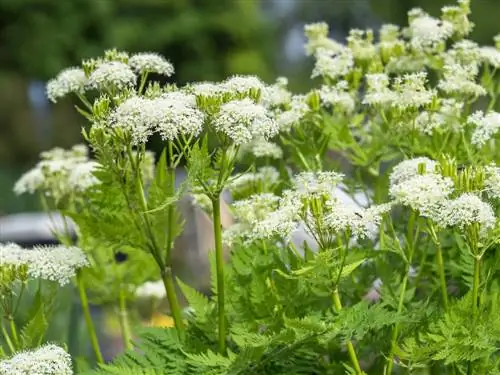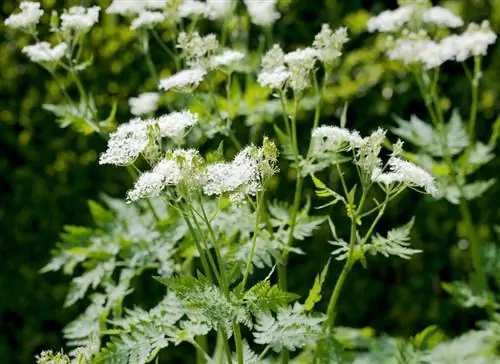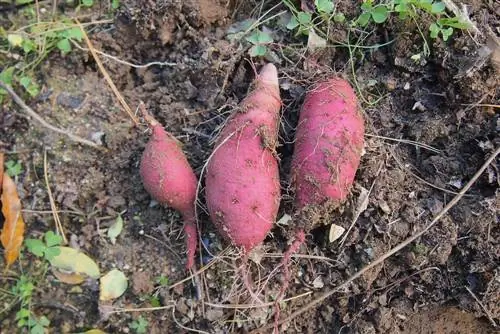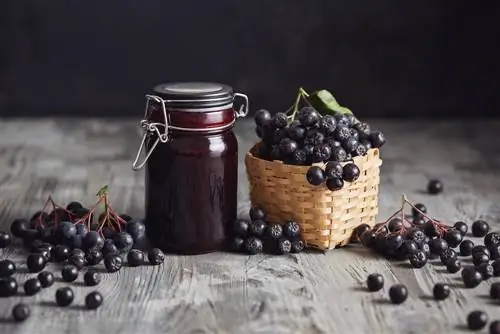- Author admin [email protected].
- Public 2023-12-16 16:46.
- Last modified 2025-06-01 06:02.
Read the commented sweet umbel profile here for useful information about growth, leaves, flowering and use. Many tips about the correct planting and care of Myrrhis odorata.
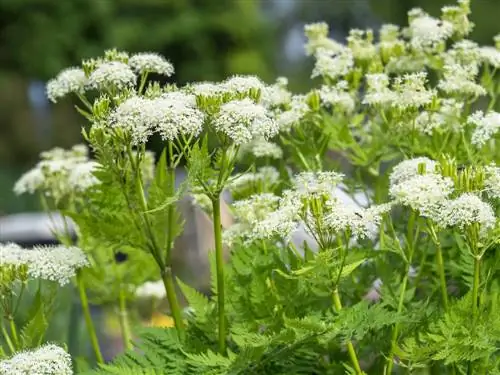
What is the sweet umbel and how can it be used?
The sweet umbel (Myrrhis odorata) is a perennial, herbaceous perennial with pinnate leaves, white umbel flowers and an anise-like scent. It thrives in sunny to shady locations and prefers fresh, nutrient-rich soil. It can be used as an ornamental plant, culinary herb or medicinal plant.
Profile
- Scientific name: Myrrhis odorata
- Family: Umbelliferae (Apiaceae)
- Synonym: myrrh chervil
- Growth type: Perennial
- Growth habit: upright, bushy, spreading
- Growth height: 60 cm to 200 cm
- Leaf: pinnate
- Flower: double umbel
- Fruit: Split Fruit
- Consumption quality: all parts of the plant are edible
- Winter hardiness: hardy
- Use: ornamental plant, culinary herb, medicinal plant
Growth
The sweet umbel (Myrrhis odorata) thrives as a perennial, herbaceous plant on the edges of forests, in riparian forests and in the mountains. As the only plant species within the genus Myrrhis, the magnificent umbelliferous plant scores with special advantages. This includes a pleasant scent of anise, which the species name “odorata” refers to, meaning fragrant. The popular name myrrh chervil indicates its close botanical relationship with chervil. All parts of the plant are edible and pamper the palate with an aromatic, sweet taste that is reminiscent of licorice. These characteristics of growth make the local natural treasure a feast for the senses:
- Growth habit: upright, spreading, densely bushy perennial with arching, sloping pinnate leaves and white umbel flowers.
- Height: 60 cm to 120 cm, rarely up to 200 cm.
- Growth width: 40 cm to 60 cm, rarely up to 100 cm.
- Stem: distinctively furrowed, lushly branched in the upper part.
- Roots: carrot-shaped taproots with a dense network of fine roots.
- Gardenically interesting properties: easy to care for, undemanding, hardy, edible, intensely fragrant, decorative, bee-friendly.
Video: Sweet umbel - herbal treasure for every garden
Leaf
Shortly after the last strong frost, the sweet umbel provides the first fresh green in the garden. Beautiful leaves sprout happily with these distinctive features:
- Leaf shape: petiolate, double to quadruple pinnate, serrated leaf edge.
- Leaf color: light green to medium green.
- Arrangement on the shoot: alternate
- Texture: soft, underside of leaf as well as leaf sheath and petiole with downy hair.
- Leaf properties: edible, smells appetizing when crushed.
Bloom
From spring to summer, these characteristic umbel flowers dominate the pretty foliage:
- Inflorescence: double umbel with 4 to 24 rays, consisting of numerous individual flowers.
- Single flower: simple, white, five-petaled, 1 cm to 4 cm in diameter.
- Flowering time: April/May to June/July.
- Special features: aromatic, edible, rich in easily accessible nectar.
In the inflorescence of a sweet umbel there are hermaphrodite female and male individual flowers. Purely male flowers without ovaries or styles in the center of the umbel gather primarily in the dominant terminal umbel, surrounded by hermaphrodite or female individual flowers with several carpels. The side umbels that bloom later usually only contain male flowers.
Fruit
Fertilized sweet umbel flowers transform into showy fruits with these characteristics:
- Fruit shape: oblong-lanceolate, 1.5 to 2.5 cm long, beaked.
- Fruit color: initially green, when fully ripe shiny dark brown.
- Fruit ripeness: from August/September.
- Fruit properties: edible
- Taste: like licorice.
The dark brown seeds contained in the ripe split fruits are cold germinators.
Usage
For good reason, the sweet umbel is mentioned in the same breath as the most useful cultivated plants for beds and balconies. First-class consumption quality, seductive scent, essential oils and a decorative appearance allow imaginative ideas to bubble up for these possible uses:
| ornamental plant | creative idea | Culinary herbs | culinary idea | Medicinal plant/healing effects |
|---|---|---|---|---|
| Perennial bed | ornamental leader perennial | leaves | spicy ingredient for fish, meat, vegetables | appetizing |
| Flowerbed | decorative cut flower | Flowers | tasty salad ingredient | Stomach-soothing |
| Natural Garden | Group of three as a bee pasture | Seeds | crunchy bread topping | expectorant |
| potted garden | potted plant with privacy function | Roots | cooked as vegetables | antibacterial |
| Herbal spiral | Eye-catcher in the temperate zone | Fruit bases | Liquorice flavored snack | blood purifying |
Sweet umbels are a tasty addition to natural cuisine. The leaves are ideally used fresh and are only added to the pot at the end of cooked dishes. The peeled roots delicately refine vegetable casseroles, potato and game dishes. High concentrations of essential oils make the seeds a high-quality spice for baked goods, fish, meat and sauces. Prolonged baking, roasting or cooking does not affect the special aroma of sweet umbel seeds. Prepared as a tea, myrrh chervil relieves annoying complaints such as stomach pressure, coughs or sore throats.
Planting sweet umbel
You can buy a ready-to-plant sweet umbel in any well-stocked nursery for a price of around 7 euros. Planting is cheaper after growing on the windowsill or by direct sowing in the bed. Read these practical tips about the correct planting in the bed and on the balcony:
Location
The demands of a sweet umbel in terms of location, soil and substrate quality are modest:
- Sun, partial shade to shade.
- Normal garden soil, ideally fresh, moist, nutrient-rich, calcareous, humic and loose and permeable.
Organic, nutrient-rich vegetable soil is suitable as a potting substrate, enriched with algae lime or rock dust for an extra portion of lime and lava granules for the best permeability without waterlogging.
Sowing
As cold germinators, sweet umbel seeds require several weeks of cold stimulus to germinate. This is ensured by uncomplicated stratification when growing on the windowsill. Seeds sown directly overcome germination inhibition naturally. These tips summarize all the important conditions for sowing:
- Sowing under glass: Keep seeds moist for 2 to 4 weeks at 18° to 22° Celsius, then expose them outside to cool temperatures between - 4° and + 4° Celsius for 4 to 6 weeks and move them back indoors.
- Direct sowing: sow seeds about 2 cm deep in bed soil in September/October, keep moist with a fine spray, cover with leaves and brushwood before the first frost.
Planting Tips
The best time to plant a sweet umbel perennial that you have grown yourself or purchased ready to plant is in autumn. Basically, the window for planting is open all year round as long as the ground is not frozen. A look at these tried-and-tested planting tips will be rewarded with magnificent growth, an intoxicating scent and an aromatic treat:
- The correct planting distance in the bed is 40 cm to 60 cm.
- A spacious planting pit with an extra loosened base promotes the growth of the taproot.
- For initial fertilization, one third of the excavation is enriched with compost and horn shavings.
- As a container plant, plant the sweet umbel in a deep container, such as a rustic zinc bucket or former palm pot.
- The perfect planter has holes in the bottom for water drainage.
- Drainage made of gravel, grit, expanded clay or pottery shards prevents waterlogging.
- The planting depth in the bed and pot corresponds to the planting depth in the cultivation or purchase container and takes a watering edge into account.
Young plants complete a two-week acclimatization phase in partial shade, provided they are given a place in the sun.
Excursus
Caution: risk of confusion - poisonous look-alikes
Highly poisonous umbelliferous plants look very similar to Myrrhis odorata. These primarily include spotted hemlock (Conium maculatum), dog parsley (Aethusa cynapium) and water hemlock (Cicuta virosa). By buying a sweet umbel from your trusted nursery, you can reliably avoid the dangerous risk of mix-ups when collecting them in the wild.
Care for the sweet umbel
The sweet umbel is an easy-care perennial. The local natural beauty is satisfied with a regular supply of water and nutrients. Cutting and harvesting go hand in hand. Winter protection is only required for potted plants. A myrrh chervil provides enough propagation material for numerous offspring. How to properly care for Myrrhis odorata:
Pouring
- When it is dry, water the sweet umbel thoroughly with normal tap water.
- Determine the watering requirement for potted plants in a sunny location using daily finger samples.
Fertilize
- Fertilize bedding plants in March/April with compost and horn shavings.
- Provide potted plants with liquid vegetable fertilizer monthly from April to October.
Cutting, harvesting
- Cut flower stems as cut flowers in the morning; Remove the lower leaflets.
- Harvest fresh leaves from May to October (particularly aromatic shortly before flowering).
- Pinch off green seeds from July/August for crispy fresh consumption.
- Harvest ripe, brown fruits in autumn for propagation by sowing.
- Dig up roots in autumn for preparation as a vegetable or side dish.
- Pluck out dead stems in winter or cut them off at ground level.
Wintering
As a classic perennial, the sweet umbel draws in its above-ground parts of the plant in winter. The root ball overwinters in the soil undamaged at temperatures of up to -30° Celsius. Young stems and fresh leaves sprout from it in early spring. A cover made of leaves and coniferous twigs is only recommended as winter protection in the year of planting.
In the pot, however, myrrh chervil is vulnerable to frost. A fleece covering protects the root ball from frost damage. Ideally, you should put the bucket in a dark, frost-free winter quarters.
Propagation
The sweet umbel is easy and reliable to propagate by sowing. Ideally, you harvest the dark brown seeds in autumn and sow them directly as soon as possible. Alternatively, wait for the results of self-sowing and dig up the most promising seedlings for planting in the new location. Division is less suitable as a propagation method because the perennial grows a deep taproot.
Popular varieties
Breeding interventions cannot improve the special properties of Myrrhis odorata. For this reason, sweet umbel varieties are not yet available.
FAQ
Does the sweet umbel have healing properties?
A sweet umbel contains various essential oils that have a beneficial healing effect. Prepared as a tea, leaves, flowers or seeds relieve stomach problems, coughs and sore throats, among other things. Herbalists recommend sweet umbel tea as part of a blood cleansing treatment in spring. In homeopathy, myrrh chervil is known as globules for the treatment of varicose veins and hemorrhoids. In combination with lavender, lemon balm and other aromatic herbs, sweet umbel plays an important role in aromatherapy.
How can you recognize a sweet umbel?
The sweet umbel is a sprawling, herbaceous perennial with large, pinnate leaves. A growth height of up to 2 meters is not uncommon. From April to July, bright white umbel flowers unfold above the pretty foliage. If you look closely, you can see downy hair on the undersides of the leaves, the petioles and the leaf sheaths. If you rub the soft leaves between your fingers, you will notice an intense, aromatic scent of anise and licorice. However, it is not advisable to try it in the wild, because the sweet umbel looks very similar to the highly poisonous spotted hemlock.
Is the sweet umbel hardy?
The sweet umbel is a native perennial and reliably hardy. Biting frost down to -30° Celsius does not cause any problems for the wild weeds. The umbelliferous plant moves in in winter and sprouts again in early spring.
Is the sweet umbel protected?
The sweet umbel originally comes from the Alpine regions of Central and Southern Europe. Today the perennial is widespread throughout Europe and is not endangered. However, Myrrhis odorata should not be taken from nature in large numbers. Apart from the risk of confusion with the highly poisonous spotted hemlock, the sweet umbel serves as an important food plant for our endangered insect world,

